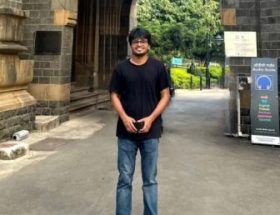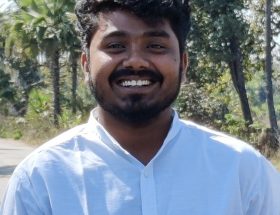Hemangi Kadlak
 [A Speech on the Occasion of 130th Birth Anniversary of Dr Babasaheb Ambedkar.]
[A Speech on the Occasion of 130th Birth Anniversary of Dr Babasaheb Ambedkar.]
Jai Bhim,
First of all, I would like to thank the Ambedkar Society for South Asia for inviting me as a speaker for this webinar to celebrate the 130th birth anniversary of Dr Ambedkar. Today’s webinar topic is the ‘Unfinished Legacy of Dr Ambedkar and the Plight of Oppressed in South Asia’. I personally wanted to work collaboratively with all South Asian countries; for this I tried and am trying my best to connect with them. I feel this is the best opportunity to mingle with them all. I want to work with them on the topics of caste, gender, occupation (mostly sanitation occupation). I have been doing research and been actively involved in the issues of sanitation workers, their children and families for more than sixteen years. This is a most neglected topic even in the anti-caste movement. Dr Ambedkar understood the complexity in relation with caste and sanitation occupation and the plight of the sanitation workers. He said, “In India, a man is not a scavenger because of his work. He is a scavenger because of his birth irrespective of the question of whether he does scavenging or not”.
The Unfinished Legacy of What and from Whom?
Which legacy are we talking about? The legacy of acquiring education, intelligence, honesty, secure human rights, respect to others, dignity, equality, fraternity, justice, democracy and treating every human as a human. This unfinished legacy was started by the Buddha and carried forward by Samrat Ashoka, Jotirao Phule, Savitribai Phule, Chhatrapati Shahu Maharaj and Dr Ambedkar. After Dr Ambedkar, this unfinished legacy was carried forward by different personalities and organisations — among them are Manyavar Kanshiram, organisations like BAMCEF, Samata Sainik Dal, etc. All our forefathers had fought for this great legacy and each one carried forward this legacy in their respective generations.
Dr Ambedkar carried the legacy from his teacher, the ‘Buddha’. Buddha believed that each individual has certain potentials, capabilities irrespective of caste, gender, class, religion etc. If everyone gets an opportunity and proper conditions to grow everyone can reach high. He said anyone can become a Buddha. The Buddha’s philosophical successor is Samrat Ashoka. He spread the legacy of gender justice by sending his son Mahendra and daughter Sanghmitra to Sri Lanka to spread Buddhism. During his regime, education was a top most priority. Likewise, Mahatma Jotiba Phule understood the importance of education and he and his wife Savitribai Phule struggled hard to spread education among the masses. They fought to give justice, spread equality across caste, gender, and religion by spreading education among the masses. Chhatrapati Shahu Maharaj was a pioneer who started reservation among the downtrodden and spread education. He sponsored the higher education of Dr Ambedkar. Dr Ambedkar also carried the same legacy to transform generations by spreading education.
The legacy of humanity, sisterhood, brotherhood, love, and fraternity these people carried transcends generations. Dr Ambedkar took forward the same legacy and worked for SC, ST, OBC, minorities, women’s empowerment and employees’ issues. He has fought to give representation to the downtrodden in education and employment. That is called the ‘Education Revolution’. He fought for women’s rights, empowerment, equal opportunity in education and employment. He linked women’s empowerment to break the caste shackles. He advised women to take lead in the social movement to liberate the masses from caste. He allowed women to get property rights. He asked women to maintain a friendly relationship with their husbands and to refuse to be a slave to men. He even advised parents to give the best education to their children. He mentioned lower caste women not to think of lower posts or peon posts for their children in offices, but to aspire for higher posts, be judges in courts etc. He even worked for employees’ rights for equal pay for equal work, eight hours work time etc.
The biggest contribution in the reclamation of human personality is the conversion from the Hindu religion to the Buddhist religion. This conversion was a change in thinking, behaviour, and lifestyle. This conversion gave confidence, global identity to the downtrodden people; it is a path to liberation. Through conversion, people started believing their inner potentials, capabilities. Through conversion, Dr Ambedkar reintroduced Buddha to the masses. Another biggest contribution is the drafting of the constitution. The constitution of India is an open gate to challenge the orthodox dogmas of this country. The constitution has given rights to people; the preamble of the constitution itself says, “WE THE PEOPLE OF INDIA”. This phrase itself confirms that every person of this country has the right to claim his/her rights. Caste never gave the feeling of “WE” but the constitution has given the feeling of “WE”. Fundamental rights, duties secured the rights of every individual of this country. The directive principles of state policy compel the state to be a welfare state for common people.
After Dr Ambedkar, this legacy of working for humanity has been carried forward by some people and organisations. But the question remains: after so much work do we get justice, equality? The answer is a big NO. We still face the same humiliation, inequality, atrocities, exploitation, discrimination. Therefore here we have to intervene to take forward the legacy, carried from Buddha to Dr Ambedkar. It is the unfinished legacy of our forefathers for reclamation of human personality by “WE THE PEOPLE OF INDIA”.
Thank You!
~~~
Dr Hemangi Kadlak works as an Assistant Professor at SNDT Women’s University, Mumbai. She is the founder member of InfinIdea Foundation and an active member of the Phule-Ambedkarite movement.










